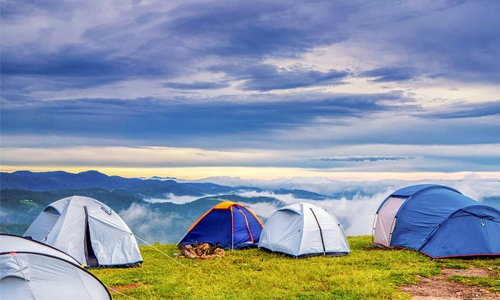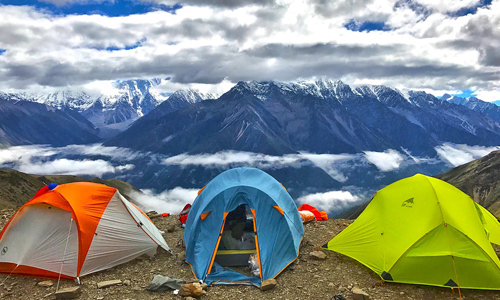Freestanding v/s Non- Freestanding tents
Author

Mike has a real passion for cycling, hiking and just generally being outdoors. Being from Warrington, he is only a few hours away from North Wales, The Peak District, Yorkshire and the Lake District. He has climbed Mount Kilimanjaro and done a lot of the mountains in the Lake District. His new passion is walking his dog and enjoying a pint at the end.
If you want to be a camper, you first need to understand the most basic skill that comes with it. Knowing what type of Tent suits you. When you go out to buy a tent, you find yourself lost and wondering when you see two categories of tents, one labelled Freestanding while the other is Non- Freestanding. Worry no more, because all your questions will be answered as you read ahead.
There are pros and cons to everything. Following is an analysis of all the pros and cons of the characteristics these two tents have that might help you choose the one that is suitable for you.

Features of Non- Freestanding Tents
- Trekking Pole Support
Though these tents come with poles to support, it gives campers an advantage as they can be replaced with trekking poles.
Pro - It decreases the overall tent weight and is easy to replace if damaged.
Con - Adjustable trekking poles might slide down during the night and so trekking poles must be purchased separately.
- Stability is on Stakes
These tents literally rely on stakes and guy - lines for structural stability and cannot stand fully taut independently.
Pro - If staked correctly, they hold up well during strong winds and harsh weather.
Con - You need to get out of your comfort zone to practice and perfect staking the tents correctly for a firm grip.
- Is it a Single Wall Construction?
These tents have a single wall construction which means they don’t require an additional rainfly or waterproof cover.
Pro - It is less likely to get wet during rains. The single wall structure lowers the overall tent weight.
Con - Poor ventilation as compared to dual wall tents and interior condensation is more likely to be found.
Features of Freestanding Tents:
- Staking Does Not Stabilize Structure
These tents are made with an in-built stable structure which doesn’t require support from stakes.
Pros - Easy and quick assembly. Can be used on hard or concrete ground where stakes are hard to insert.
Cons - Might not be as stable as non- freestanding tents during extreme weather conditions.
- Pre-inserted Tent Poles
The structural stability for these is achieved by the poles already inserted in the tent.
Pros - A quick fix for any occasion and easy to clean.
Cons - Difficult to replace poles if damaged during the trip. Overall weight of the tent is increased.

- Is it a Double-wall Construction?
These tents usually come with a heavy exterior or a double wall construction as they call it. The inner layer is the tent itself while the outer layer is the waterproof rainfly.
Pros - The polyester rainfly and the interior made with nylon mesh provide a good ventilation system.
Cons - The rainfly that is added over the tent makes it more exposed to the weather and your valuables are more likely to get wet during rains. It also adds to the overall weight off the tent.
It is only obvious that you will purchase a tent that suits your pocket, but factors like the conditions where you are going to camp also matter a great deal. In case of a big group of campers or your family, freestanding tents are the ideal choice as they are available in big sizes. However, the non-freestanding tent makes a great choice for frequent backpackers and trekkers as it is lightweight.
I wish this information is helpful for everyone who finds themselves clueless while buying a tent and hope that you have a great vacation while exploring the outdoors with your friends and family.
Author

Mike has a real passion for cycling, hiking and just generally being outdoors. Being from Warrington, he is only a few hours away from North Wales, The Peak District, Yorkshire and the Lake District. He has climbed Mount Kilimanjaro and done a lot of the mountains in the Lake District. His new passion is walking his dog and enjoying a pint at the end.
Categories
- Sport (28)
- Product Reviews (3)
- Team Outdoor Look (7)
- Mike Wild (2)
- Mike Payton (2)
- Suse Hammond-Pears (3)
- Snowboarding (12)
- Latest Offers (105)
- Shop Talk (1)
- Competitions (7)
- Walking (413)
- Lifestyle Fashion (8)
- Travel (86)
- Kit Guides (176)
- Workwear Clothing (6)
- Safety Workwear (4)
- Health/Fitness (289)
- Skiing (91)
- Great Outdoors (1316)
- Cycling (92)
- January 2025
- December 2024
- November 2024
- October 2024
- September 2024
- August 2024
- July 2024
- June 2024
- May 2024
- April 2024
- March 2024
- February 2024
- January 2024
- December 2023
- November 2023
- October 2023
- September 2023
- August 2023
- July 2023
- June 2023
- May 2023
- April 2023
- March 2023
- February 2023
- January 2023
- December 2022
- November 2022
- October 2022
- September 2022
- August 2022
- July 2022
- June 2022
- May 2022
- April 2022
- March 2022
- February 2022
- January 2022
- December 2021
- November 2021
- October 2021
- September 2021
- August 2021
- July 2021
- June 2021
- May 2021
- April 2021
- March 2021
- February 2021
- January 2021
- December 2020
- November 2020
- October 2020
- September 2020
- August 2020
- July 2020
- June 2020
- May 2020
- April 2020
- March 2020
- February 2020
- January 2020
- December 2019
- November 2019
- October 2019
- September 2019
- August 2019
- July 2019
- June 2019
- May 2019
- April 2019
- March 2019
- February 2019
- January 2019
- December 2018
- November 2018
- October 2018
- September 2018
- August 2018
- July 2018
- June 2018
- May 2018
- April 2018
- March 2018
- February 2018
- January 2018
- December 2017
- November 2017
- October 2017
- September 2017
- August 2017
- July 2017
- June 2017
- May 2017
- April 2017
- March 2017
- February 2017
- January 2017
- December 2016
- November 2016
- October 2016
- September 2016
- August 2016
- July 2016
- June 2016
- May 2016
- April 2016
- March 2016
- February 2016
- January 2016
- December 2015
- November 2015
- October 2015
- September 2015
- August 2015
- July 2015
- June 2015
- May 2015
- April 2015
- March 2015
- February 2015
- January 2015
- December 2014
- November 2014
- October 2014
- September 2014
- August 2014
- July 2014
- June 2014
- May 2014
- April 2014
- March 2014
- February 2014
- January 2014
- December 2013
- November 2013
- October 2013
- September 2013
- August 2013
- July 2013
- June 2013
- May 2013
- April 2013
- March 2013
- February 2013
- January 2013
- December 2012
- November 2012
- October 2012
- September 2012
- August 2012
- July 2012
- June 2012
- May 2012
- April 2012
- March 2012
- February 2012
- January 2012
- December 2011
- November 2011
- October 2011
- September 2011
- August 2011
- May 2010
- April 2010
- March 2010
- February 2010
- January 2010
- November 2009
- October 2009
- September 2009
Submit a Comment